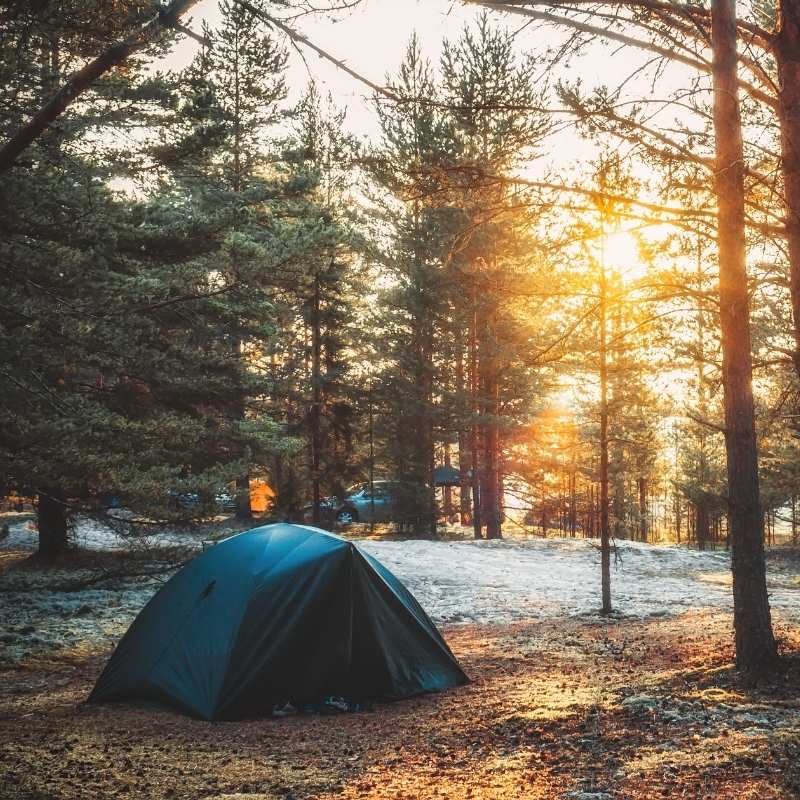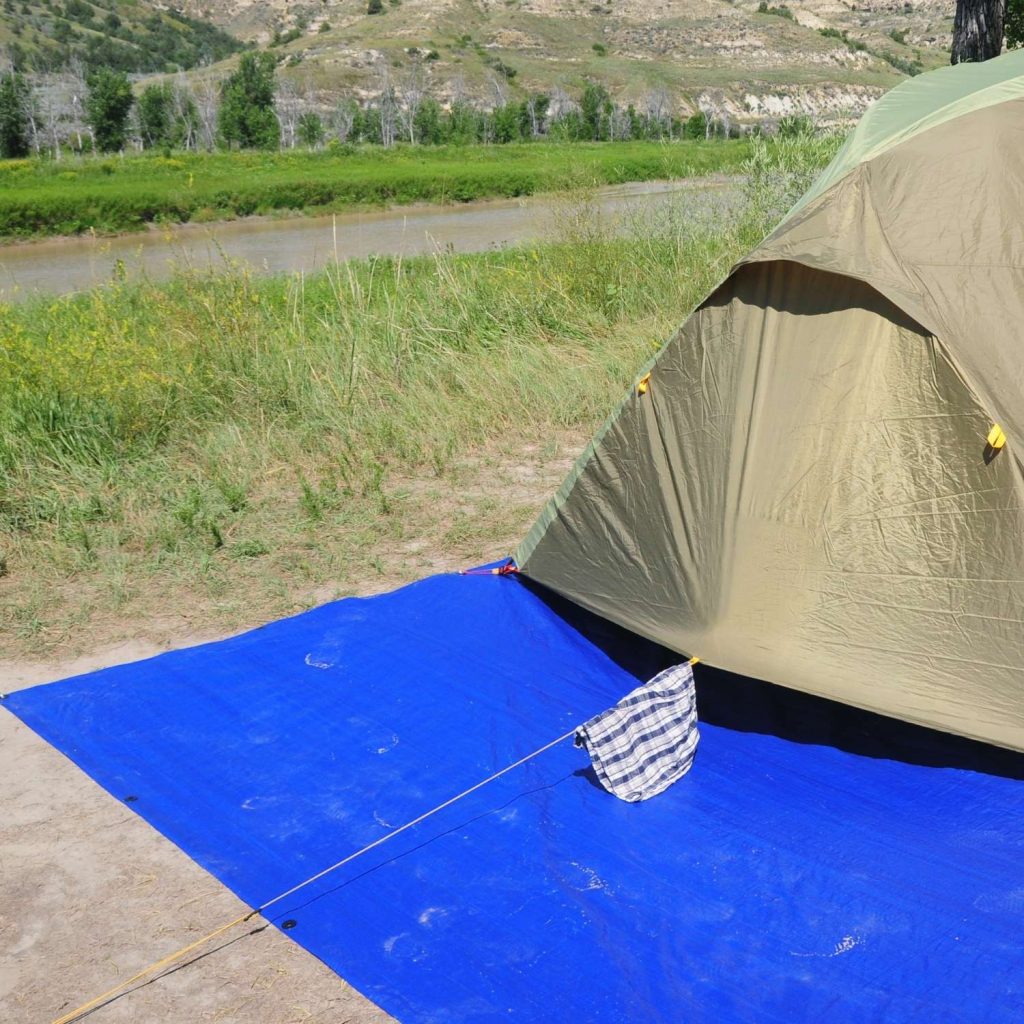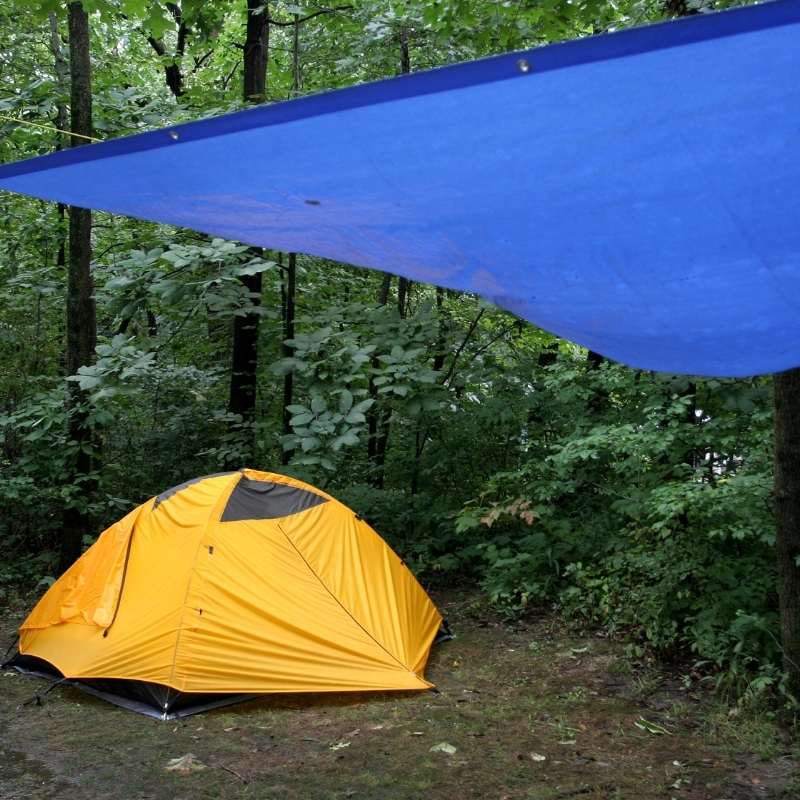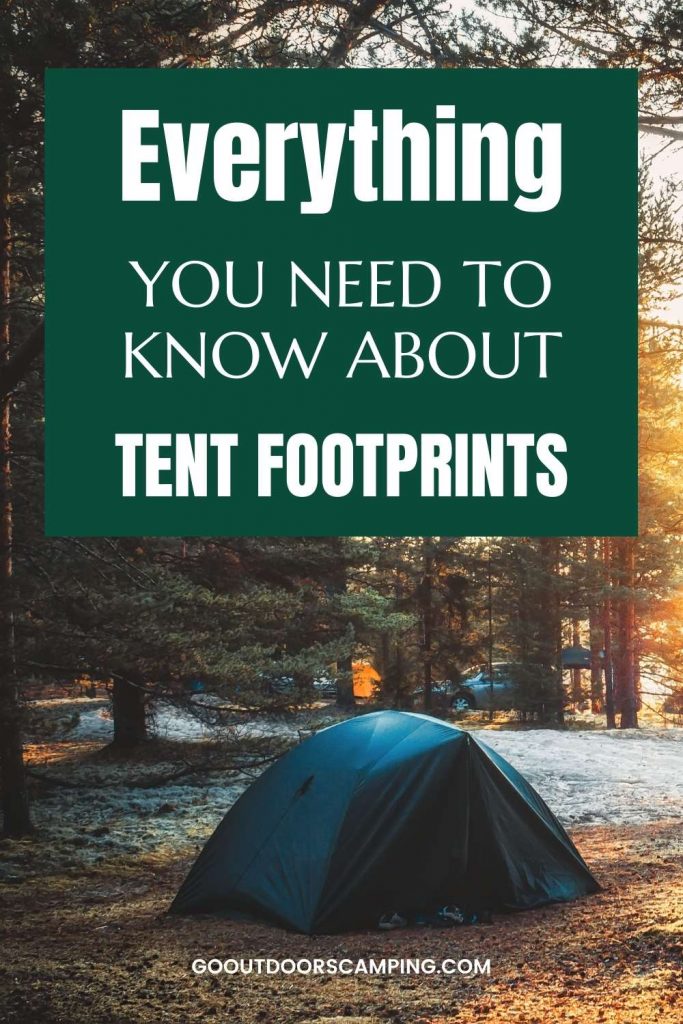Do I need a tarp under my tent? Learn more about tent footprints and the purpose of footprints for tents.
You might be wondering if you really need to purchase a footprint for your tent. We think they are an important piece of camping equipment that can often be overlooked. This article tells you everything you need to know about footprints.

The 3 Main Purposes of a Tent Footprint
Tent footprints, or groundsheets, serve a few important purposes. They keep your tent floor clean, dry, and protected from wear and tear.
1. Keeps Your Tent Floor Clean
You can do your best to find a clear, clean spot when setting up your tent. However, without protection, you’re likely to end up with things like mud and tree sap on the bottom of your tent. Laying down a footprint first creates a barrier that will keep the floor of your tent clean. This saves you time and effort later when it’s time to pack up.
2. Keeps Your Tent Floor Dry
Even if you put your tent on dry ground, it is not protected from the moisture held in the ground below it. Footprints act as a water and vapor barrier between the ground and the floor of your tent.
If your tent floor is not waterproof, has leaky seams, or has a nick or tear, the water from the ground plus any rain can come up and soak your sleeping bags and anything else on the ground in your tent. Having a correctly sized groundsheet can prevent this.
3. Protects Your Tent from Wear and Tear
A quality tent can cost you quite a bit of money. You’ll want to protect your investment as much as you can by avoiding excess wear that will have you buying another tent. Placing your tent directly on the ground or a tent pad can scuff and tear the bottom.
Whether you set your tent up on the dirt or a pad, there are usually rocks, concrete, and dirt that can wear down the bottom layer of your tent. Putting a groundsheet down first can protect your tent from rubbing on debris and getting torn or worn out.

Gooutdoorscamping.com is a participant in the Amazon Services LLC Associates Program, an affiliate advertising program designed to provide a way for websites to earn advertising revenues by advertising and linking to Amazon.com. This means that, at zero cost to you, I will earn an affiliate commission if you click through the link and finalize a purchase.
Do You Need a Tent Footprint?
You can camp in a tent without a footprint. Some tents even come with a footprint so you won’t need to buy an additional one.
However, if you tent doesn’t come with a footprint, we recommend looking into buying one. You can find our top picks here. They are relatively inexpensive and for the reasons above, we think they are important.
If you choose not to use a groundsheet, we recommend that you at least use a tent that has a good, thick floor that is waterproof. You should also be extra careful when setting up your tent. Avoid placing the tent on sharp debris and sliding it across the ground.
Another precaution you can take is placing a tarp or barrier on the inside of your tent. Keeping things like sleeping bags and pack bags off the tent floor would be a good idea also.
Tent Footprints Vs. a Tarp
You can use a tarp instead of purchasing a footprint made specifically for a tent. A waterproof tarp, usually made of polyester, can work much the same as a groundsheet or footprint. Just make sure that the tarp you purchase is, in fact, waterproof and durable enough to use in place of a groundsheet.
Like footprints, most tarps have eyelets or grommets that you can use to place stakes through to hold them in place.
The main difference between a footprint and a tarp is the sizing. Footprints are typically sized to specifically fit underneath a tent. Tarps can come in similar sizes but may need to be cut or folded to fit a tent.
How to Choose a Tent Footprint
When choosing a footprint for your tent, there are a few different things to consider. We have determined that you can choose between a regular, waterproof tarp or footprint. But you still need to choose a size and make sure you are getting waterproof, quality material.
Sizing
Generally, you want your footprint to match or be slightly smaller than your tent. Otherwise, the excess material can be somewhat of a rain catcher and pool water around your tent edges. However, if rain isn’t a concern, some people choose to use an oversized groundsheet to place supplies and other items on while protecting them from the ground.

Material
Diving into the fabric used for tents and footprints can get pretty technical. We have a post on tent material ratings that are much the same. You’ll see material ratings like Pu1000mm, 210T ripstop and 210D ripstop. So, what do these mean when looking for a footprint?
PU1000mm is the minimum rating of a waterproof fabric. The higher the PU number, the more waterproof the fabric is. When purchasing a footprint, you definitely want it to be at least a PU1000mm to keep water out.
The T and D ratings will tell you how durable the material is. The D, or denier, rating refers to the weight of the material. The higher the D-rating, the heavier and better the material. T stands for thread count and works in the same way as bed sheets. The count is the number of threads woven in 1 square inch of material. The higher the count, the tighter and stronger the weave.
Ripstop materials mean that the weaving of material is reinforced in a way that makes them tear and rip resistant.
Footprint Care and Storage
You’ll want to take care of your footprint, or groundsheet, in a similar way to your tent. Doing so will help prolong the life of the material enabling you to keep the benefits of using your footprint.
When packing up, we usually shake out our footprint to make sure as much debris is left behind. If we have enough water or a water source, we will rinse it off to get sand and dirt particles off that would otherwise scratch the material when folding it up and storing it.
At home, we deep clean our materials before storing them for a longer time. When doing so, it is important to use a non-detergent soap if you need to use soap at all. In the bathtub or the yard, we use cold water to rinse the material along with the mild, non-fragranced soap and a soft sponge or washcloth to work on any spots that aren’t cleaned with water.
Make sure that your footprint is completely dry before rolling it up and storing it. Putting it away wet can cause mildew and mold.
Other Uses for Footprints or Groundcovers
We already talked about how footprints are pretty similar to tarps. You can use a tarp as a footprint if you want to. Likewise, you can use a footprint as a tarp. Whichever you choose, you can use them for multiple things around your camp site:
- Extra rain protection for your tent if used like a rainfly
- Groundcover to store supplies on
- Shade canopy
- Rain protection canopy
- A shelter for firewood or other supplies and equipment
- Wind blocker

DIY Tent Footprints
You don’t have to purchase a footprint that was made specifically for being a tent footprint. There are other materials that work great as DIY groundsheets. Just make sure that whatever you use will not allow moisture to come through any stacked seams and that the material will withstand debris and wear.
Some popular DIY footprints include:
- Regular tarps
- Vapor barrier plastic (the kind they use in crawlspaces to block vapor/water)
- Housewrap (Tyvek is a popular brand you can find at your local home store)
- Polyethylene sheeting/Painter’s plastic (commonly used for as painting protection and drop cloths)
Like using a regular footprint, the most common practice is to size these materials to your tent. Making sure that none of the material extends passed your tent which can be a catchall for water.
So, Are Tent Footprints Worth It?
Now that we’ve shared all we know about footprints, are they worth it? Like, should you buy or make and use one? We think the answer should always be yes.
For as much practical use you get out of them, we think footprints are definitely worth the purchase and room in your camping supplies. Since they keep your tent in good shape and can be used for so many other things, you really can’t go wrong when purchasing a footprint.
Now that we’ve talked about footprints, you may want to jump over to our article on blackout tents, Dutch ovens, or Dutch oven meals and desserts to prepare for your next camping adventure.
Save this post for later!

Leave a Reply